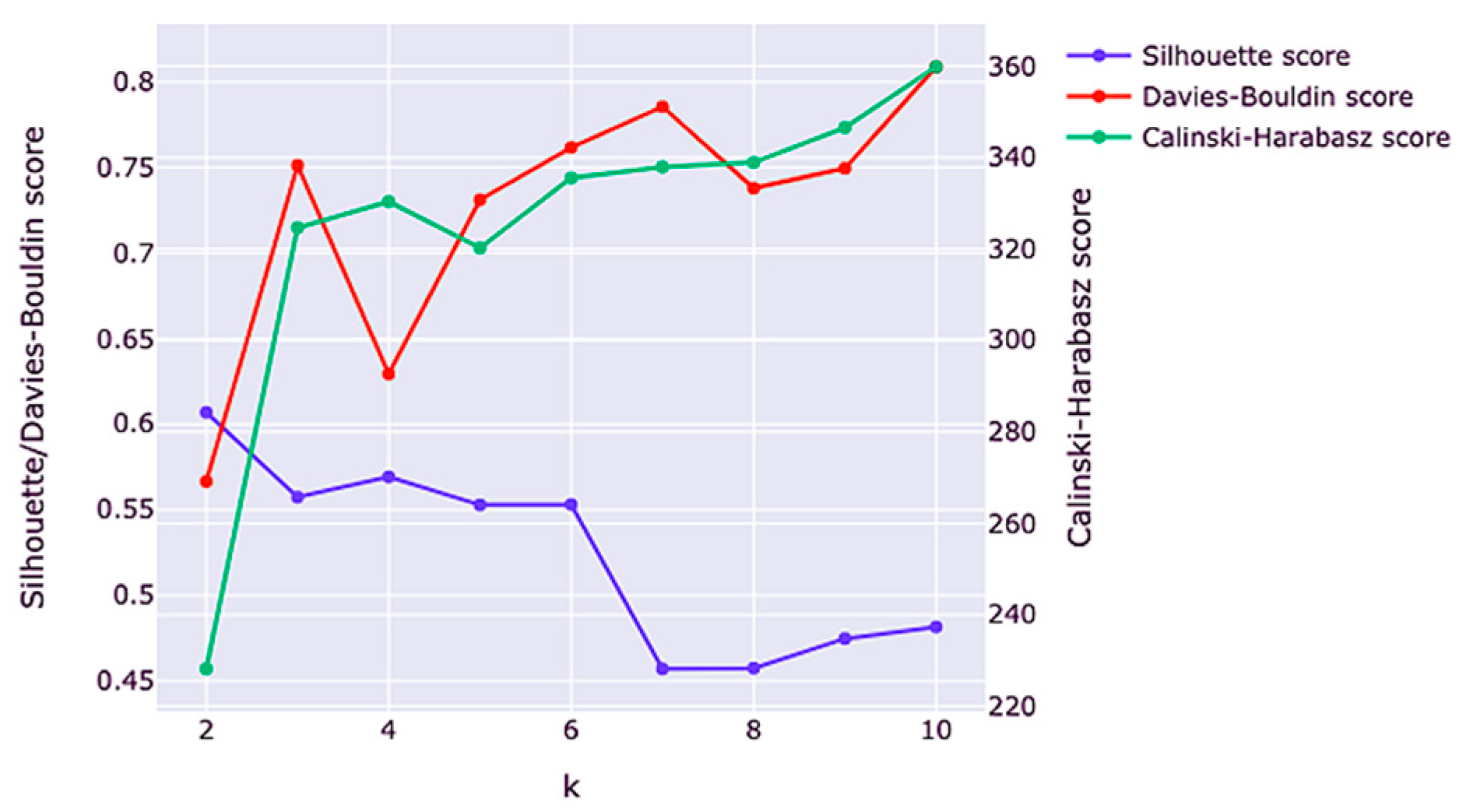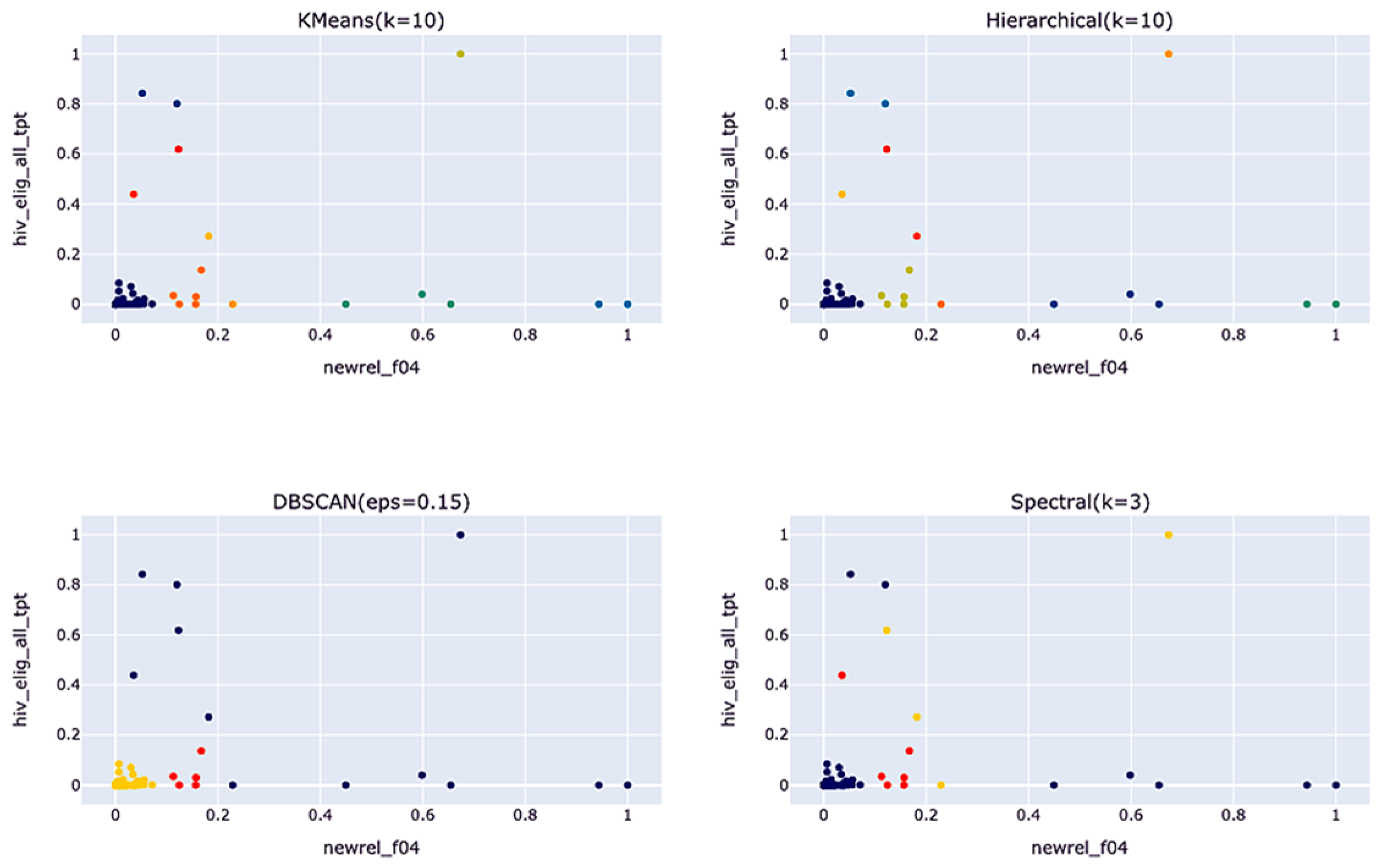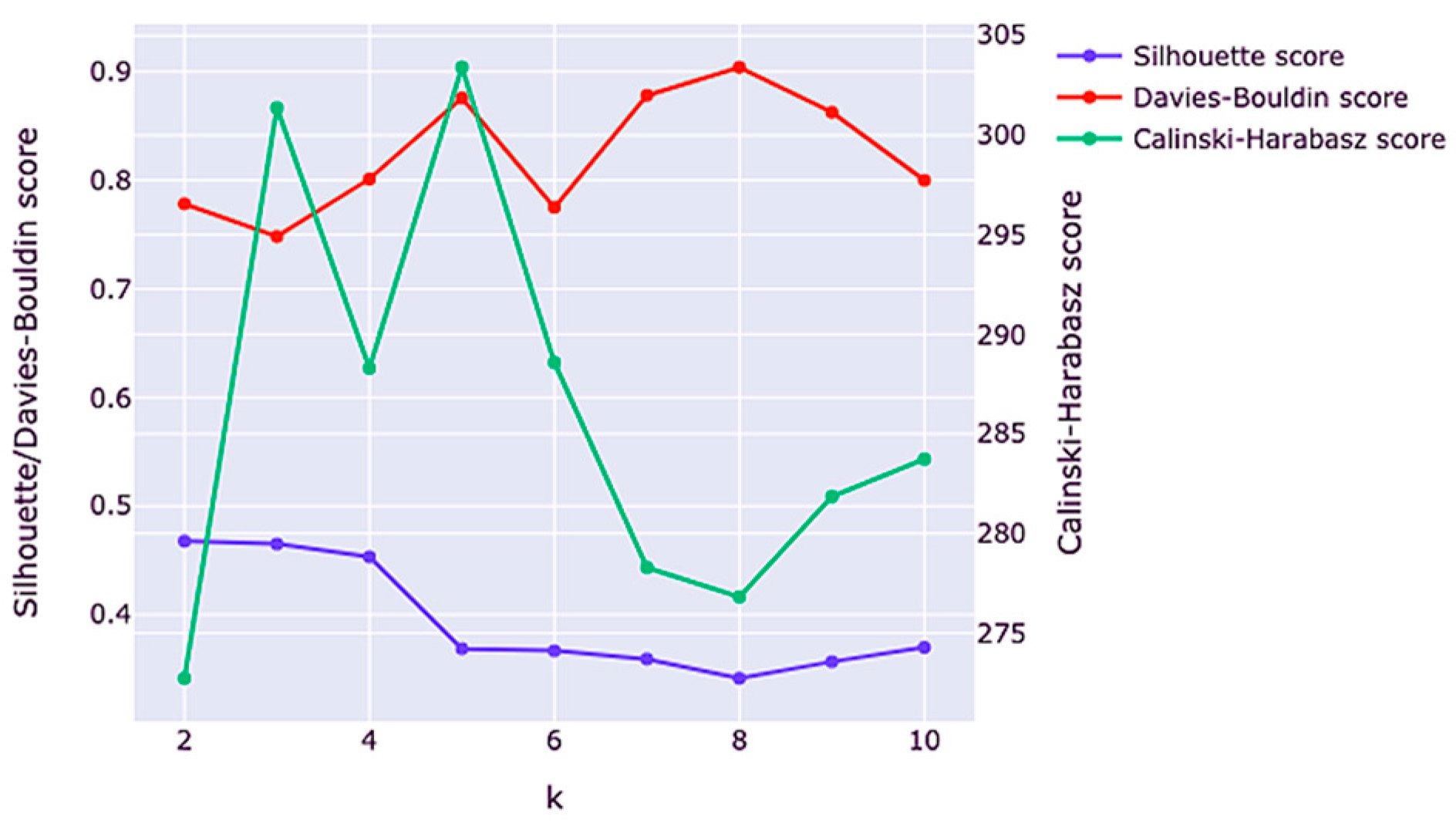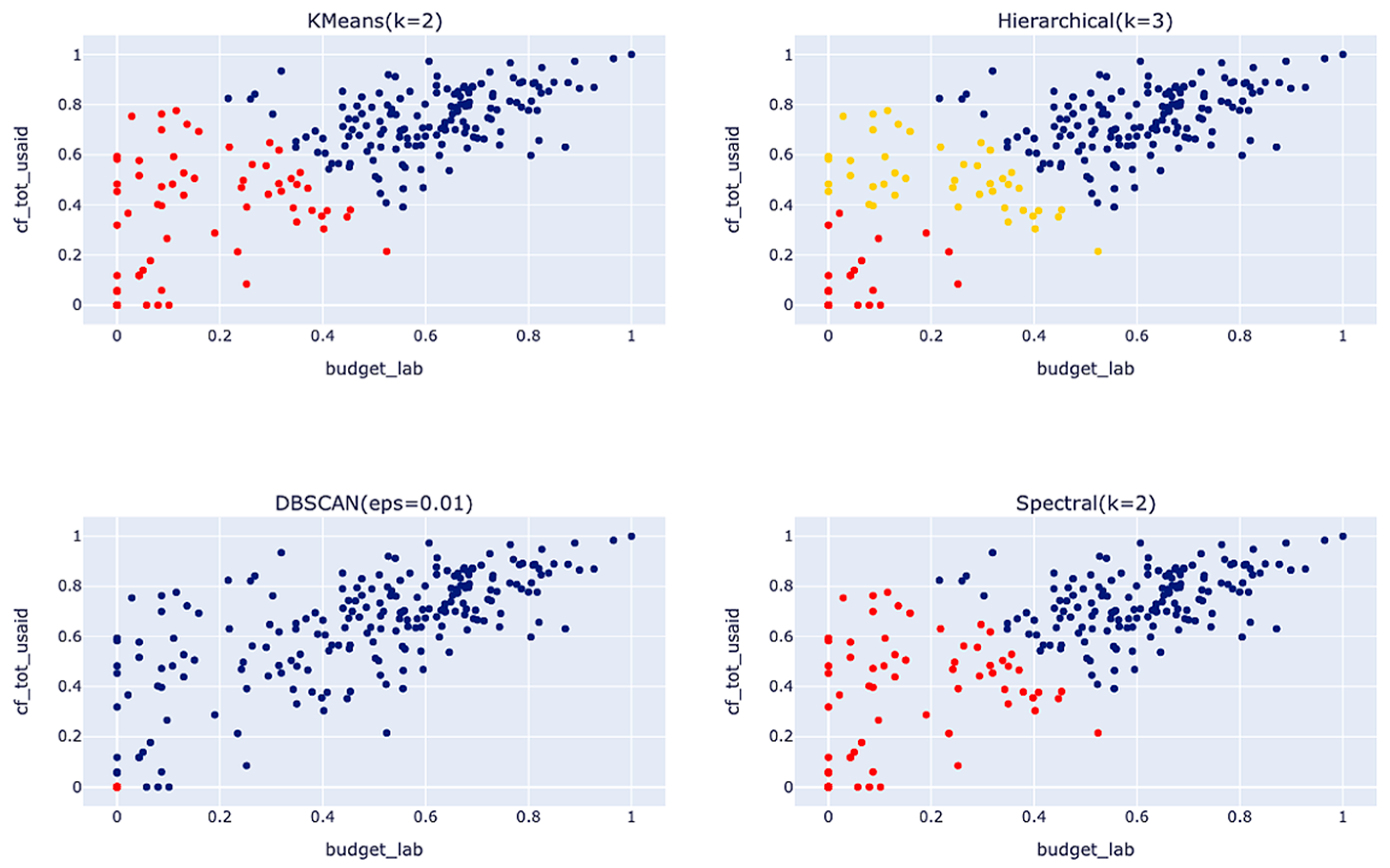Quantitative Comparison of Machine Learning Clustering Methods for Tuberculosis Data Analysis †
Abstract
1. Introduction
2. Methods
2.1. Data Preprocessing
- Estimation Data: This category includes variables related to the estimation and prediction of TB cases, such as mortality rates and historical case counts.
- Notification Data: Notification data encompass information related to the formal reporting of TB cases to health authorities, including notification rates, geographical locations, and notification-related features.
- Budget Data: Budget data comprises information on financial allocations, expenditures, and resource utilization for TB control and treatment programs.
- Outcome Data: This category encompasses variables associated with TB treatment outcomes, including treatment success rates, patient recovery status.
2.2. K-Means
- The process of initialising k cluster centroids can be performed in two ways: randomly or by selecting data points as initial centroids.
- The process involves assigning each individual data point to the centroid that is closest to it, so creating k clusters.
- The centroids can be recalculated by computing the mean of all data points within each cluster.
2.3. Hierarchical Clustering
- Single Linkage: Distance between the closest data points in two clusters.
- Complete Linkage: Distance between the farthest data points in two clusters.
- Average Linkage: Average distance between all data point pairs in two clusters.
- Ward’s Linkage: Minimizes the increase in total within-cluster variance when merging clusters.
- To initiate the clustering process, each individual data point is initially assigned as a separate cluster;
- The clusters are merged iteratively by considering the nearest clusters according to the selected linkage criterion;
- The merging process should be continued until either all data points are assigned to a single cluster or a predetermined ending criterion is satisfied.
2.4. DBSCAN
- (epsilon): A radius that defines the neighbourhood around each data point;
- MinPts: The minimum number of data points required to form a dense region (including the data point itself).DBSCAN categorizes data points into three main types:
- Core Point: A data point with at least data points within its ε-neighborhood;
- Border Point: A data point within the ε-neighbourhood of a Core Point but with fewer than data points within its own -neighborhood;
- Noise Point: The concept of a “Noise Point” refers to a specific data point inside a dataset that does not meet the criteria of being classified as either a “Core Point” or a “Border Point”.
- Randomly select an unvisited data point.
- If the selected point is a Core Point, create a new cluster and add it to the cluster.
- Expand the cluster by adding all reachable, unvisited Core Points and Border Points to the cluster.
- Repeat steps 1–3 until no more data points can be added to the cluster.
- If there are unvisited data points, return to step 1 and start a new cluster.
2.5. Spectral Clustering
- The construction of a similarity graph captures the relationships between data points, where edges represent similarities;
- The graph Laplacian, whether unnormalized or normalized, transforms the graph into a format suitable for spectral analysis;
- Eigenvalue decomposition extracts the eigenvectors and eigenvalues of the Laplacian matrix;
- Spectral embedding reduces the dimensionality of the data while preserving cluster structures in lower-dimensional space;
- Clustering is performed on the embedded data using a chosen algorithm, typically K-means.
2.6. Silhouette Score
2.7. Davies–Bouldin Index
- For each cluster , calculate its centroid representing the centre of the cluster;
- For each cluster , calculate the average distance between each data point in and the centroid denoted as :
- 3.
- For each cluster calculate the pairwise dissimilarity between cluster and all other clusters (where ) as:
- 4.
- For each cluster find the cluster with which it has the highest similarity, i.e., the minimum
- 5.
- The Davies–Bouldin Index is then calculated as the average of these maximum similarities across all clusters:
2.8. Calinski–Harabasz Index
- Calculate the overall mean of the data points, denoted as :
- 2.
- Calculate the within-cluster variance (W) as the sum of the variances of each cluster:
- 3.
- Calculate the between-cluster variance (B) as the sum of variances between the cluster centroids and the overall mean:
- 4.
- Compute the Calinski–Harabasz Index as the ratio of the between-cluster variance (B) to the within-cluster variance (W):
3. Results
4. Conclusions
Author Contributions
Funding
Institutional Review Board Statement
Informed Consent Statement
Data Availability Statement
Conflicts of Interest
References
- Zhou, Z.-H. Machine Learning; Springer Nature: Singapore, 2021; XIII, 459p. [Google Scholar]
- Raschka, S. Python Machine Learning; Packt Publishing Ltd.: Birmingham, UK, 2015; 454p. [Google Scholar]
- Wardani, R.S.; Sayono, P.; Paramananda, A. Clustering tuberculosis in children using K-Means based on geographic information system. AIP Conf. Proc. 2019, 2114, 060012. [Google Scholar] [CrossRef]
- Momahhed, S.S.; Emamgholipour Sefiddashti, S.; Minaei, B.; Shahali, Z. K-means clustering of outpatient prescription claims for health insureds in Iran. BMC Public Health 2023, 23, 788. [Google Scholar] [CrossRef] [PubMed]
- Dookie, N.; Padayatchi, N.; Naidoo, K. Tuberculosis elimination in the era of coronavirus disease 2019 (COVID-19): A moving target. Clin. Infect. Dis. 2022, 74, 509–510. [Google Scholar] [CrossRef] [PubMed]
- Orjuela-Canon, A.D.; Jutinico, A.L.; Awad, C.; Vergara, E.; Palencia, A. Machine learning in the loop for tuberculosis diagnosis support. Front. Public Health 2022, 10, 876949. [Google Scholar] [CrossRef] [PubMed]
- Jafarzadegan, M.; Safi-Esfahani, F.; Beheshti, Z. Combining hierarchical clustering approaches using the PCA method. Expert Syst. Appl. 2019, 137, 1–10. [Google Scholar] [CrossRef]
- Sinaga, K.P.; Yang, M.-S. Unsupervised K-Means Clustering Algorithm. IEEE Access 2020, 8, 80716–80727. [Google Scholar] [CrossRef]
- WHO. Global Tuberculosis Report, 27 October 2022. Available online: https://www.who.int/ (accessed on 7 July 2023).
- Reddy, G.T.; Reddy, M.P.; Lakshmanna, K.; Kaluri, R.; Rajput, D.S.; Srivastava, G.; Baker, T. Analysis of Dimensionality Reduction Techniques on Big Data. IEEE Access 2020, 8, 54776–54788. [Google Scholar] [CrossRef]
- Zhao, H.; Zheng, J.; Xu, J.; Deng, W. Fault Diagnosis Method Based on Principal Component Analysis and Broad Learning System. IEEE Access 2019, 7, 99263–99272. [Google Scholar] [CrossRef]
- Ashari, I.; Banjarnahor, R.; Farida, D.; Aisyah, S.; Dewi, A.; Humaya, N. Application of Data Mining with the K-Means Clustering Method and Davies Bouldin Index for Grouping IMDB Movies. J. Appl. Inform. Comput. 2022, 6, 7–15. [Google Scholar] [CrossRef]
- Deng, D. DBSCAN Clustering Algorithm Based on Density. In Proceedings of the 2020 7th International Forum on Electrical Engineering and Automation (IFEEA), Hefei, China, 25–27 September 2020; pp. 949–953. [Google Scholar] [CrossRef]
- Sun, G.; Cong, Y.; Dong, J.; Liu, Y.; Ding, Z.; Yu, H. What and How: Generalized Lifelong Spectral Clustering via Dual Memory. IEEE Trans. Pattern Anal. Mach. Intell. 2022, 44, 3895–3908. [Google Scholar] [CrossRef] [PubMed]
- Shahapure, K.R.; Nicholas, C. Cluster Quality Analysis Using Silhouette Score. In Proceedings of the 2020 IEEE 7th International Conference on Data Science and Advanced Analytics (DSAA), Sydney, NSW, Australia, 6–9 October 2020; pp. 747–748. [Google Scholar]
- Ogbuabor, G.; Ugwoke, F. Clustering algorithm for a healthcare dataset using silhouette score value. Int. J. Comput. Sci. Inf. Technol. (IJCSIT) 2018, 10, 27–37. [Google Scholar] [CrossRef]
- Mughnyanti, M.; Efendi, S.; Zarlis, M. Analysis of determining centroid clustering x-means algorithm with davies-bouldin index evaluation, In Proceedings of the IOP Conference Series: Materials Science and Engineering. IOP Conf. Ser. Mater. Sci. Eng. 2020, 725, 012128. [Google Scholar] [CrossRef]
- PyShark. Davies-Bouldin Index for K-Means Clustering Evaluation in Python, 2021, PythonBloggers.com. Available online: https://pythonbloggers.com/2021/06/davies-bouldin-index-fork-means-clustering-evaluation-in-python (accessed on 7 July 2023).
- Yedilkhan, D.; Mukasheva, A.; Bissengaliyeva, D.; Suynullayev, Y. Performance Analysis of Scaling NoSQL vs SQL: A Comparative Study of MongoDB, Cassandra, and PostgreSQL. In Proceedings of the 2023 IEEE International Conference on Smart Information Systems and Technologies (SIST), Astana, Kazakhstan, 4–6 May 2023; pp. 479–483. [Google Scholar] [CrossRef]
- Maulik, U.; Bandyopadhyay, S. Performance evaluation of some clustering algorithms and validity indices. IEEE Trans. Pattern Anal. Mach. Intell. 2002, 24, 1650–1654. [Google Scholar] [CrossRef]
- Ashari, I.; Dwi Nugroho, E.; Baraku, R.; Novri Yanda, I.; Liwardana, R. Analysis of Elbow, Silhouette, Davies-Bouldin, Calinski-Harabasz, and Rand-Index Evaluation on K-Means Algorithm for Classifying Flood-Affected Areas in Jakarta. J. Appl. Inform. Comput. 2023, 7, 95–103. [Google Scholar] [CrossRef]
- Mukasheva, A.; Koishiyev, D.; Suimenbayeva, Z.; Rakhmatullaeva, S.; Bolshibayeva, A.; Sadikova, G. Comparison evaluation of Unet-based models with noise augmentation for breast cancer segmentation on ultrasound image. East.-Eur. J. Enterp. Technol. 2023, 5, 85–97. [Google Scholar] [CrossRef]












| Method | Silhouette Score | Davies–Bouldin Score | Calinski–Harabasz Score |
|---|---|---|---|
| KMeans (k = 2) | 0.921888 | 0.896547 | 233.083908 |
| KMeans (k = 3) | 0.942814 | 0.460119 | 564.180086 |
| KMeans (k = 4) | 0.936618 | 0.372054 | 482.829735 |
| KMeans (k = 5) | 0.937319 | 0.265713 | 700.255366 |
| KMeans (k = 6) | 0.930778 | 0.360036 | 825.631145 |
| KMeans (k = 7) | 0.885819 | 0.387040 | 1084.524869 |
| KMeans (k = 8) | 0.883502 | 0.346847 | 1548.910942 |
| KMeans (k = 9) | 0.883538 | 0.304381 | 1781.357804 |
| KMeans (k = 10) | 0.882582 | 0.213537 | 1962.860713 |
| Hierarchical (k = 2) | 0.924705 | 0.901919 | 230.272882 |
| Hierarchical (k = 3) | 0.942814 | 0.460119 | 564.180086 |
| Hierarchical (k = 4) | 0.941624 | 0.318242 | 627.803845 |
| Hierarchical (k = 5) | 0.937319 | 0.265713 | 700.255366 |
| Hierarchical (k = 6) | 0.895864 | 0.407496 | 1021.746228 |
| Hierarchical (k = 7) | 0.895045 | 0.415851 | 1312.444535 |
| Hierarchical (k = 8) | 0.886553 | 0.390947 | 1669.164844 |
| Hierarchical (k = 9) | 0.809496 | 0.488679 | 1827.003481 |
| Hierarchical (k = 10) | 0.807232 | 0.436929 | 2133.874560 |
| DBSCAN (ε = 0.01) | 0.806189 | 1.244112 | 86.984049 |
| DBSCAN (ε = 0.02) | 0.854295 | 1.133252 | 120.141415 |
| DBSCAN (ε = 0.03) | 0.878016 | 1.058013 | 147.406641 |
| DBSCAN (ε = 0.04) | 0.885626 | 1.026981 | 159.757449 |
| DBSCAN (ε = 0.05) | 0.885626 | 1.026981 | 159.757449 |
| DBSCAN (ε = 0.06) | 0.911349 | 0.934416 | 209.653276 |
| DBSCAN (ε = 0.07) | 0.911349 | 0.934416 | 209.653276 |
| DBSCAN (ε = 0.08) | 0.916373 | 0.911491 | 222.581546 |
| DBSCAN (ε = 0.09) | 0.916373 | 0.911491 | 222.581546 |
| DBSCAN (ε = 0.10) | 0.916373 | 0.911491 | 222.581546 |
| DBSCAN (ε = 0.11) | 0.921888 | 0.896547 | 233.083908 |
| DBSCAN (ε = 0.12) | 0.921888 | 0.896547 | 233.083908 |
| DBSCAN (ε = 0.13) | 0.921888 | 0.896547 | 233.083908 |
| DBSCAN (ε = 0.14) | 0.924705 | 0.901919 | 230.272882 |
| DBSCAN (ε = 0.15) | 0.924705 | 0.901919 | 230.272882 |
| DBSCAN (ε = 0.16) | 0.924705 | 0.901919 | 230.272882 |
| Spectral (k = 2) | 0.927732 | 0.861168 | 228.212784 |
| Spectral (k = 3) | 0.940250 | 0.400739 | 485.133303 |
| Spectral (k = 4) | 0.854569 | 0.614904 | 436.856959 |
| Spectral (k = 5) | 0.809416 | 0.930598 | 365.402493 |
| Spectral (k = 6) | 0.533718 | 0.924874 | 291.017199 |
| Spectral (k = 7) | −0.061049 | 16.544091 | 254.267550 |
| Spectral (k = 8) | −0.230689 | 6.928392 | 197.336032 |
| Spectral (k = 9) | −0.297636 | 10.410599 | 171.848693 |
| Spectral (k = 10) | −0.233370 | 5.421388 | 149.588401 |
| Method | Silhouette Score | Davies–Bouldin Score | Calinski–Harabasz Score |
|---|---|---|---|
| KMeans (k = 2) | 0.942705 | 0.289393 | 625.038025 |
| KMeans (k = 3) | 0.905911 | 0.402616 | 720.649708 |
| KMeans (k = 4) | 0.902634 | 0.315524 | 732.222635 |
| KMeans (k = 5) | 0.861461 | 0.391989 | 904.214898 |
| KMeans (k = 6) | 0.885724 | 0.413518 | 1143.276872 |
| KMeans (k = 7) | 0.881099 | 0.390891 | 1746.970170 |
| KMeans (k = 8) | 0.882095 | 0.267941 | 1786.333354 |
| KMeans (k = 9) | 0.823738 | 0.537225 | 1981.053036 |
| KMeans (k = 10) | 0.849126 | 0.356672 | 2011.028563 |
| Hierarchical (k = 2) | 0.942705 | 0.289393 | 625.038025 |
| Hierarchical (k = 3) | 0.905911 | 0.402616 | 720.649708 |
| Hierarchical (k = 4) | 0.906682 | 0.359964 | 769.083541 |
| Hierarchical (k = 5) | 0.864937 | 0.636404 | 902.603930 |
| Hierarchical (k = 6) | 0.883104 | 0.409142 | 1117.594503 |
| Hierarchical (k = 7) | 0.882580 | 0.364382 | 1692.680790 |
| Hierarchical (k = 8) | 0.879857 | 0.456697 | 1782.923876 |
| Hierarchical (k = 9) | 0.813840 | 0.508241 | 1974.335965 |
| Hierarchical (k = 10) | 0.810734 | 0.414324 | 2284.732735 |
| DBSCAN (ε = 0.01) | 0.786429 | 1.070687 | 109.283498 |
| DBSCAN (ε = 0.02) | 0.809581 | 1.026351 | 126.473773 |
| DBSCAN (ε = 0.03) | 0.830719 | 0.982316 | 146.991170 |
| DBSCAN (ε = 0.04) | 0.815291 | 1.142252 | 104.125035 |
| DBSCAN (ε = 0.05) | 0.897377 | 0.788539 | 289.932073 |
| DBSCAN (ε = 0.06) | 0.906467 | 0.734014 | 337.825357 |
| DBSCAN (ε = 0.07) | 0.914212 | 0.679914 | 392.062907 |
| DBSCAN (ε = 0.08) | 0.920791 | 0.624156 | 452.104032 |
| DBSCAN (ε = 0.09) | 0.920791 | 0.624156 | 452.104032 |
| DBSCAN (ε = 0.10) | 0.920791 | 0.624156 | 452.104032 |
| DBSCAN (ε = 0.11) | 0.920791 | 0.624156 | 452.104032 |
| DBSCAN (ε = 0.12) | 0.920791 | 0.624156 | 452.104032 |
| DBSCAN (ε = 0.13) | 0.924631 | 0.581839 | 493.927175 |
| DBSCAN (ε = 0.14) | 0.942705 | 0.289393 | 625.038025 |
| DBSCAN (ε = 0.15) | 0.942705 | 0.289393 | 625.038025 |
| DBSCAN (ε = 0.16) | 0.942705 | 0.289393 | 625.038025 |
| Spectral (k = 2) | 0.942705 | 0.289393 | 625.038025 |
| Spectral (k = 3) | 0.916820 | 0.533065 | 596.430729 |
| Spectral (k = 4) | 0.871292 | 0.573779 | 575.026763 |
| Spectral (k = 5) | 0.833139 | 0.661008 | 433.307591 |
| Spectral (k = 6) | 0.662441 | 0.648925 | 348.889444 |
| Spectral (k = 7) | 0.672314 | 0.584286 | 381.794204 |
| Spectral (k = 8) | 0.375670 | 0.631871 | 250.780582 |
| Spectral (k = 9) | 0.360341 | 0.615598 | 218.433071 |
| Spectral (k = 10) | 0.333171 | 0.678220 | 247.337298 |
Disclaimer/Publisher’s Note: The statements, opinions and data contained in all publications are solely those of the individual author(s) and contributor(s) and not of MDPI and/or the editor(s). MDPI and/or the editor(s) disclaim responsibility for any injury to people or property resulting from any ideas, methods, instructions or products referred to in the content. |
© 2024 by the authors. Licensee MDPI, Basel, Switzerland. This article is an open access article distributed under the terms and conditions of the Creative Commons Attribution (CC BY) license (https://creativecommons.org/licenses/by/4.0/).
Share and Cite
Kossakov, M.; Mukasheva, A.; Balbayev, G.; Seidazimov, S.; Mukammejanova, D.; Sydybayeva, M. Quantitative Comparison of Machine Learning Clustering Methods for Tuberculosis Data Analysis. Eng. Proc. 2024, 60, 20. https://doi.org/10.3390/engproc2024060020
Kossakov M, Mukasheva A, Balbayev G, Seidazimov S, Mukammejanova D, Sydybayeva M. Quantitative Comparison of Machine Learning Clustering Methods for Tuberculosis Data Analysis. Engineering Proceedings. 2024; 60(1):20. https://doi.org/10.3390/engproc2024060020
Chicago/Turabian StyleKossakov, Marlen, Assel Mukasheva, Gani Balbayev, Syrym Seidazimov, Dinargul Mukammejanova, and Madina Sydybayeva. 2024. "Quantitative Comparison of Machine Learning Clustering Methods for Tuberculosis Data Analysis" Engineering Proceedings 60, no. 1: 20. https://doi.org/10.3390/engproc2024060020
APA StyleKossakov, M., Mukasheva, A., Balbayev, G., Seidazimov, S., Mukammejanova, D., & Sydybayeva, M. (2024). Quantitative Comparison of Machine Learning Clustering Methods for Tuberculosis Data Analysis. Engineering Proceedings, 60(1), 20. https://doi.org/10.3390/engproc2024060020







